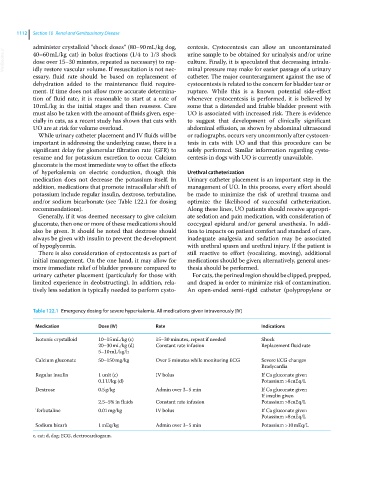Page 1174 - Clinical Small Animal Internal Medicine
P. 1174
1112 Section 10 Renal and Genitourinary Disease
administer crystalloid “shock doses” (80–90 mL/kg dog, centesis. Cystocentesis can allow an uncontaminated
VetBooks.ir 40–60 mL/kg cat) in bolus fractions (1/4 to 1/3 shock urine sample to be obtained for urinalysis and/or urine
culture. Finally, it is speculated that decreasing intralu
dose over 15–30 minutes, repeated as necessary) to rap
idly restore vascular volume. If resuscitation is not nec
catheter. The major counterargument against the use of
essary, fluid rate should be based on replacement of minal pressure may make for easier passage of a urinary
dehydration added to the maintenance fluid require cystocentesis is related to the concern for bladder tear or
ment. If time does not allow more accurate determina rupture. While this is a known potential side‐effect
tion of fluid rate, it is reasonable to start at a rate of whenever cystocentesis is performed, it is believed by
10 mL/kg in the initial stages and then reassess. Care some that a distended and friable bladder present with
must also be taken with the amount of fluids given, espe UO is associated with increased risk. There is evidence
cially in cats, as a recent study has shown that cats with to suggest that development of clinically significant
UO are at risk for volume overload. abdominal effusion, as shown by abdominal ultrasound
While urinary catheter placement and IV fluids will be or radiographs, occurs very uncommonly after cystocen
important in addressing the underlying cause, there is a tesis in cats with UO and that this procedure can be
significant delay for glomerular filtration rate (GFR) to safely performed. Similar information regarding cysto
resume and for potassium excretion to occur. Calcium centesis in dogs with UO is currently unavailable.
gluconate is the most immediate way to offset the effects
of hyperkalemia on electric conduction, though this Urethral catheterization
medication does not decrease the potassium itself. In Urinary catheter placement is an important step in the
addition, medications that promote intracellular shift of management of UO. In this process, every effort should
potassium include regular insulin, dextrose, terbutaline, be made to minimize the risk of urethral trauma and
and/or sodium bicarbonate (see Table 122.1 for dosing optimize the likelihood of successful catheterization.
recommendations). Along these lines, UO patients should receive appropri
Generally, if it was deemed necessary to give calcium ate sedation and pain medication, with consideration of
gluconate, then one or more of these medications should coccygeal epidural and/or general anesthesia. In addi
also be given. It should be noted that dextrose should tion to impacts on patient comfort and standard of care,
always be given with insulin to prevent the development inadequate analgesia and sedation may be associated
of hypoglycemia. with urethral spasm and urethral injury. If the patient is
There is also consideration of cystocentesis as part of still reactive to effort (vocalizing, moving), additional
initial management. On the one hand, it may allow for medications should be given; alternatively, general anes
more immediate relief of bladder pressure compared to thesia should be performed.
urinary catheter placement (particularly for those with For cats, the perineal region should be clipped, prepped,
limited experience in deobstructing). In addition, rela and draped in order to minimize risk of contamination.
tively less sedation is typically needed to perform cysto An open‐ended semi‐rigid catheter (polypropylene or
Table 122.1 Emergency dosing for severe hyperkalemia. All medications given intravenously (IV)
Medication Dose (IV) Rate Indications
Isotonic crystalloid 10–15 mL/kg (c) 15–30 minutes, repeat if needed Shock
20–30 mL/kg (d) Constant rate infusion Replacement fluid rate
5–10 mL/kg/h
Calcium gluconate 50–150 mg/kg Over 5 minutes while monitoring ECG Severe ECG changes
Bradycardia
Regular insulin 1 unit (c) IV bolus If Ca gluconate given
0.1 U/kg (d) Potassium >8 mEq/L
Dextrose 0.5 g/kg Admin over 3–5 min If Ca gluconate given
If insulin given
2.5–5% in fluids Constant rate infusion Potassium >8 mEq/L
Terbutaline 0.01 mg/kg IV bolus If Ca gluconate given
Potassium >8 mEq/L
Sodium bicarb 1 mEq/kg Admin over 3–5 min Potassium >10 mEq/L
c, cat; d, dog; ECG, electrocardiogram.

